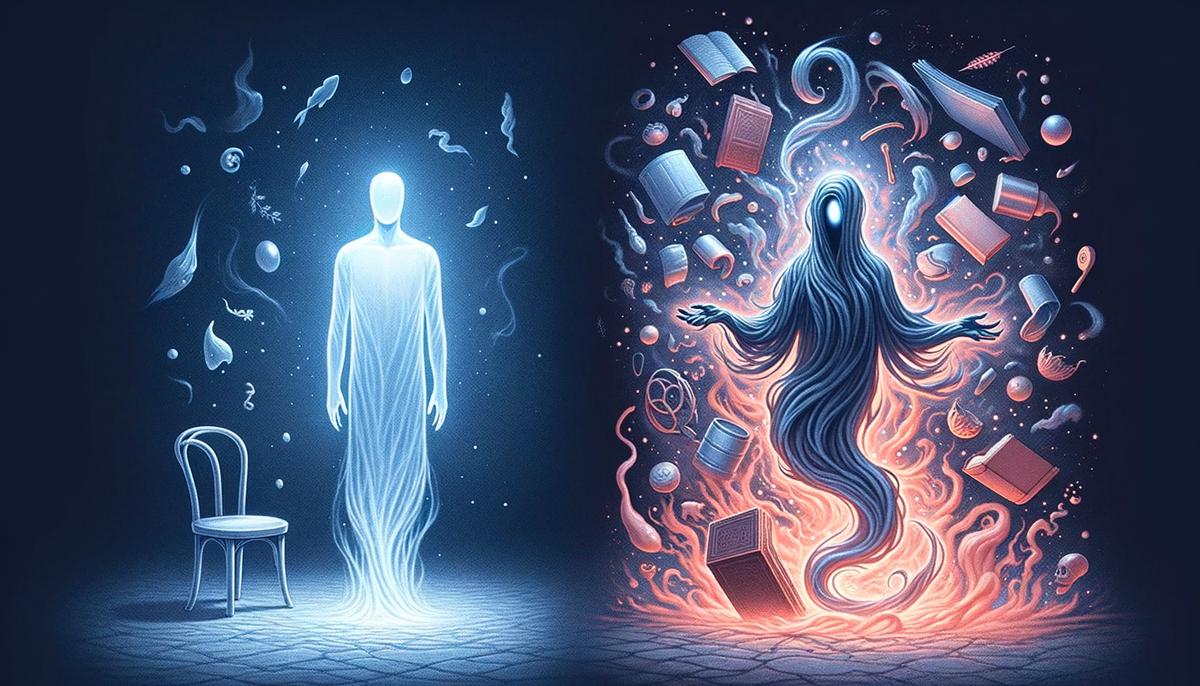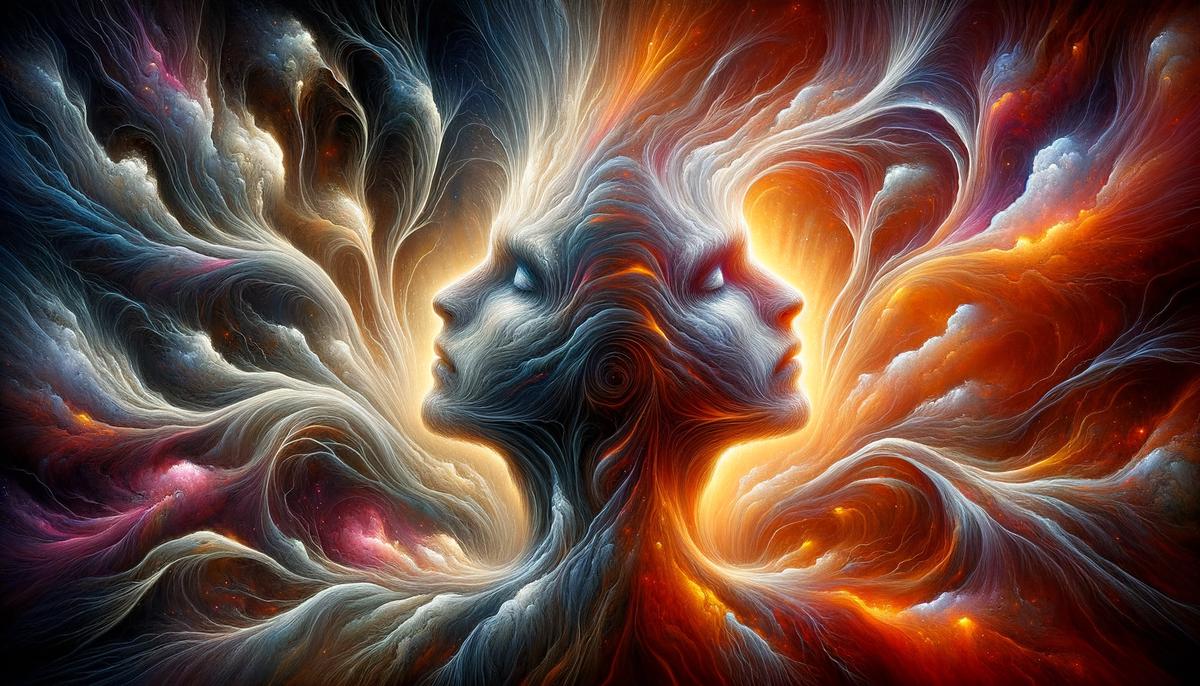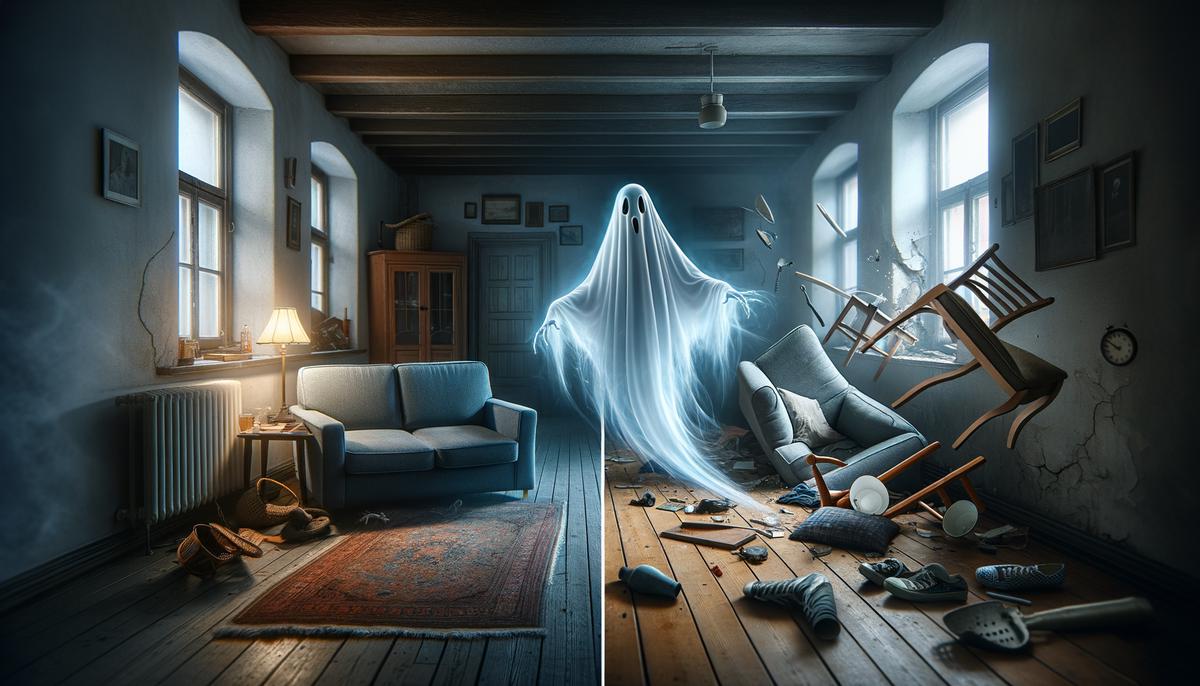Understanding the differences between ghosts and poltergeists can be quite intriguing. These entities, often lumped together in popular culture, actually have distinct characteristics and behaviors that set them apart.
Definition and Characteristics
Ghosts are spirits of deceased individuals who haven't crossed over to the other side. They often remain in places tied to their lives or deaths. They can be seen or sensed, sometimes appearing as full-bodied apparitions or simply as a cold presence. Ghosts reflect their personalities from life; a kind person in life usually results in a harmless ghost, while an unpleasant individual may turn into a more troublesome spirit.
Poltergeists, on the other hand, are known as "noisy ghosts." Unlike typical ghosts, poltergeists are rarely visible. They create disturbances by moving furniture, slamming doors, or even causing physical attacks. They're believed by some to be a manifestation of strong human emotions, often those of a troubled person, frequently a teenager.
Key Differences:
- Ghosts are tied to specific locations or objects
- Poltergeists follow emotional energy rather than being attached to a location
- Ghosts can be visible, while poltergeists are rarely seen
- Poltergeists are more disruptive and physically active
In essence, ghosts are tied to life experiences, wandering spaces familiar to them or seeking resolution. Poltergeists, with their root in kinetic emotional turmoil, use energy to impact the physical world markedly.

Behavioral Differences
While both entities are unsettling, it's their behavior that most distinguishes poltergeists from ghosts. Ghosts, typically passive, might manifest through subtle cues such as unexplained cold spots, faint whispers, or familiar scents like perfume or cigar smoke.
Poltergeists, however, operate on an entirely different level. Their hallmark trait of causing physical disturbances is not limited to mere furniture rearrangement; it encompasses activities far more chaotic and, often, violent.
| Characteristic | Ghosts | Poltergeists |
|---|---|---|
| Sounds | Soft whispers, footsteps | Loud knocks, thuds, screams |
| Temperature changes | Localized cold spots | Erratic environmental effects |
| Interaction with humans | Rarely harmful | Can be violent (scratches, bites, pushes) |
| Persistence | Sporadic, repetitive | Volatile, escalating |
The distinction between ghosts and poltergeists can also be understood through their persistence and patterns of behavior. Ghosts may appear sporadically and exhibit repetitive behaviors tied to their life experiences. Poltergeists generate a much more volatile presence. Their disruptive actions can start mildly and quickly escalate into a whirlwind of chaotic activity.
Origins and Influences
The origins and influences that give rise to ghosts and poltergeists are as varied as the human experiences that shape their existence. Each entity emerges from a unique interplay of emotional states, unresolved trauma, and environmental factors.
Ghost Origins:
- Sudden or violent deaths
- Unfinished business
- Strong emotional attachments
- Locations with traumatic histories
Poltergeists, in contrast, derive their existence from a different source of turmoil. Rather than being tied to unresolved life experiences, poltergeists are manifestations of kinetic energy fueled by the intense emotional states of living individuals. Typically, this energy originates from people undergoing high levels of stress, anxiety, or emotional upheaval, often during the tumultuous phase of adolescence.
"Poltergeist activity is often associated with adolescents, particularly females, suggesting a link between hormonal changes and psychokinetic phenomena."1
Both ghosts and poltergeists share a common trait: their reliance on different forms of energy to manifest. Ghosts draw upon the residual spiritual energy left behind by their lingering attachments and unresolved issues. Poltergeists are direct manifestations of emotional upheaval and psychic energy, reflecting the chaotic and intense feelings of those they are linked to.
Understanding these origins and influences can provide valuable insights into the nature of these paranormal phenomena, potentially offering ways to address or resolve the underlying issues that give rise to such manifestations.

Case Studies and Historical Accounts
The infamous Bell Witch haunting in Adams, Tennessee, dating back to the early 19th century, blurs the line between ghostly hauntings and poltergeist activity. The Bell family, especially young Betsy Bell, experienced phenomena from a spirit believed to be a vengeful neighbor. This specter tormented the family with disturbing auditory and physical manifestations, inflicting harm and moving objects. This case suggests that ghosts and poltergeists might sometimes operate together or that one entity can display behaviors typically attributed to both types.
The Enfield Poltergeist case in London exemplifies classic poltergeist activity. During the late 1970s, the Hodgson family experienced supernatural disturbances centered around their home, particularly involving adolescent Janet Hodgson. Witnesses reported:
- Upended furniture
- Flying objects
- Unexplained knocking sounds
Janet's voice reportedly changed, emitting strange sounds. The intensity and variety of activity observed align closely with poltergeist phenomena, potentially driven by Janet's emotional state during her teenage years.
The Amityville haunting of 1975 balances ghostly and poltergeist-like occurrences. The Lutz family reported various supernatural events, including:
- Apparitions
- Foul odors
- Cold spots
- Extreme poltergeist activities (slamming doors, taunting voices)
While controversial, the Amityville case demonstrates how human trauma and environmental factors might generate both ghostly and poltergeist manifestations.
The poltergeist in Rosenheim, Germany, during the late 1960s, presents another well-documented case. A young secretary named Anne-Marie Schneider worked in an office plagued by bizarre events:
- Phones ringing without cause
- Photocopiers spewing endless blank pages
- Inexplicably swaying ceiling lights
Investigations suggested Anne-Marie's presence correlated with increased activity, indicating strong emotional energy as the cause.
The haunting of the Whaley House in San Diego, California, leans more towards traditional ghostly activity. Built on the site of San Diego's first public gallows, the house is known for spectral sightings. Visitors and employees report encountering apparitions of Thomas Whaley, his family members, and various executed inmates. The house exhibits classic ghostly traits:
- Sudden temperature drops
- Phantom footsteps
- Unexplained scents
- Apparitions as full-bodied forms or shadowy figures
The Black Monk of Pontefract case in the UK showcases another intersection of ghost and poltergeist activity. In the 1960s, the Pritchard family endured malevolent activities in their home, allegedly haunted by a 16th-century monk's spirit. The entity demonstrated harmful intent: items flew across rooms, cold winds blew through sealed windows, and family members were dragged up stairs by unseen forces.
These historical accounts and case studies provide insight into the distinctions and overlaps between ghosts and poltergeists. Each case offers a glimpse into how theoretical differences become tangible and vivid. These stories, infused with emotional energy, reveal that while the boundaries between ghostly hauntings and poltergeist activities can blur, the underlying causes and manifestations often point to complex human experiences.
Recognizing the differences between ghosts and poltergeists is key for those interested in the supernatural. While both entities challenge our understanding of reality, they originate from different sources of emotional energy and manifest uniquely. Whether it's a ghost lingering due to unresolved issues or a poltergeist fueled by intense emotions, these phenomena remind us of the profound impact human experiences have on the unseen world.
"The universe is full of magical things patiently waiting for our wits to grow sharper." – Eden Phillpotts
As we continue to explore these phenomena, it's crucial to approach them with an open mind and a critical eye. The field of parapsychology, while controversial, offers scientific methods to investigate these occurrences1. By combining historical accounts, eyewitness testimonies, and rigorous scientific inquiry, we may one day unravel the mysteries that have captivated human imagination for centuries.

